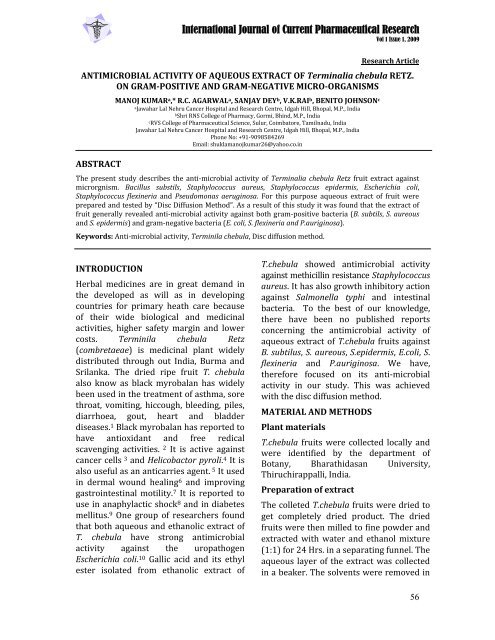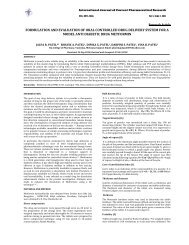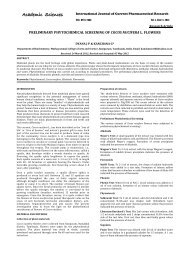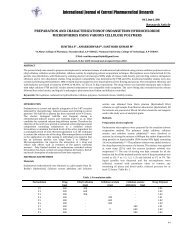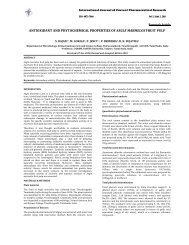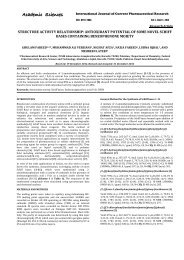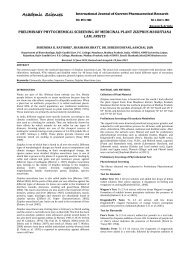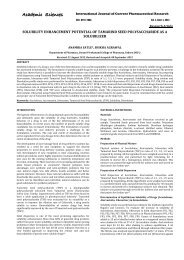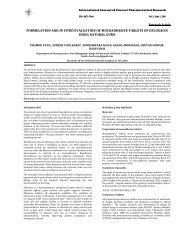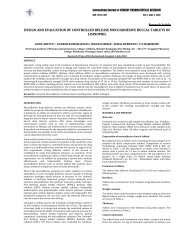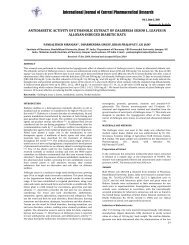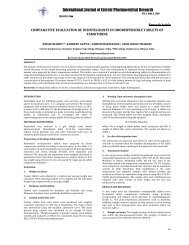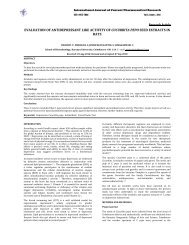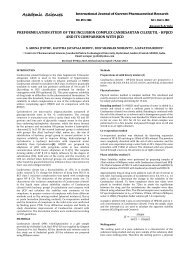ANTIMICROBIAL ACTIVITY OF AQUEOUS EXTRACT OF Terminalia ...
ANTIMICROBIAL ACTIVITY OF AQUEOUS EXTRACT OF Terminalia ...
ANTIMICROBIAL ACTIVITY OF AQUEOUS EXTRACT OF Terminalia ...
Create successful ePaper yourself
Turn your PDF publications into a flip-book with our unique Google optimized e-Paper software.
International Journal of Cur Research Article<br />
<strong>ANTIMICROBIAL</strong> <strong>ACTIVITY</strong> <strong>OF</strong> <strong>AQUEOUS</strong> <strong>EXTRACT</strong> <strong>OF</strong> <strong>Terminalia</strong> chebula RETZ.<br />
ON GRAMPOSITIVE AND GRAMNEGATIVE MICROORGANISMS<br />
ABSTRACT<br />
International Journal of Current Pharmaceutical Research<br />
Vol 1 Issue 1, 2009<br />
MANOJ KUMAR a ,* R.C. AGARWAL a , SANJAY DEY b , V.K.RAI b , BENITO JOHNSON c<br />
aJawahar Lal Nehru Cancer Hospital and Research Centre, Idgah Hill, Bhopal, M.P., India<br />
bShri RNS College of Pharmacy, Gormi, Bhind, M.P., India<br />
cRVS College of Pharmaceutical Science, Sulur, Coimbatore, Tamilnadu, India<br />
Jawahar Lal Nehru Cancer Hospital and Research Centre, Idgah Hill, Bhopal, M.P., India<br />
Phone No: +91‐9098584269<br />
Email: shuklamanojkumar26@yahoo.co.in<br />
The present study describes the anti‐microbial activity of <strong>Terminalia</strong> chebula Retz fruit extract against<br />
microrgnism. Bacillus substils, Staphylococcus aureus, Staphylococcus epidermis, Escherichia coli,<br />
Staphylococcus flexineria and Pseudomonas aeruginosa. For this purpose aqueous extract of fruit were<br />
prepared and tested by “Disc Diffusion Method”. As a result of this study it was found that the extract of<br />
fruit generally revealed anti‐microbial activity against both gram‐positive bacteria (B. subtils, S. aureous<br />
and S. epidermis) and gram‐negative bacteria (E. coli, S. flexineria and P.auriginosa).<br />
Keywords: Anti‐microbial activity, Terminila chebula, Disc diffusion method.<br />
INTRODUCTION<br />
Herbal medicines are in great demand in<br />
the developed as will as in developing<br />
countries for primary heath care because<br />
of their wide biological and medicinal<br />
activities, higher safety margin and lower<br />
costs. Terminila chebula Retz<br />
(combretaeae) is medicinal plant widely<br />
distributed through out India, Burma and<br />
Srilanka. The dried ripe fruit T. chebula<br />
also know as black myrobalan has widely<br />
been used in the treatment of asthma, sore<br />
throat, vomiting, hiccough, bleeding, piles,<br />
diarrhoea, gout, heart and bladder<br />
diseases. 1 Black myrobalan has reported to<br />
have antioxidant and free redical<br />
scavenging activities. 2 It is active against<br />
cancer cells 3 and Helicobactor pyroli. 4 It is<br />
also useful as an anticarries agent. 5 It used<br />
in dermal wound healing 6 and improving<br />
gastrointestinal motility. 7 It is reported to<br />
use in anaphylactic shock 8 and in diabetes<br />
mellitus. 9 One group of researchers found<br />
that both aqueous and ethanolic extract of<br />
T. chebula have strong antimicrobial<br />
activity against the uropathogen<br />
Escherichia coli. 10 Gallic acid and its ethyl<br />
ester isolated from ethanolic extract of<br />
T.chebula showed antimicrobial activity<br />
against methicillin resistance Staphylococcus<br />
aureus. It has also growth inhibitory action<br />
against Salmonella typhi and intestinal<br />
bacteria. To the best of our knowledge,<br />
there have been no published reports<br />
concerning the antimicrobial activity of<br />
aqueous extract of T.chebula fruits against<br />
B. subtilus, S. aureous, S.epidermis, E.coli, S.<br />
flexineria and P.auriginosa. We have,<br />
therefore focused on its anti‐microbial<br />
activity in our study. This was achieved<br />
with the disc diffusion method.<br />
MATERIAL AND METHODS<br />
Plant materials<br />
T.chebula fruits were collected locally and<br />
were identified by the department of<br />
Botany, Bharathidasan University,<br />
Thiruchirappalli, India.<br />
Preparation of extract<br />
The colleted T.chebula fruits were dried to<br />
get completely dried product. The dried<br />
fruits were then milled to fine powder and<br />
extracted with water and ethanol mixture<br />
(1:1) for 24 Hrs. in a separating funnel. The<br />
aqueous layer of the extract was collected<br />
in a beaker. The solvents were removed in<br />
56
otary evaporator and the crude extracts<br />
were dried at room temperature in a<br />
steady air current. The dried extracts were<br />
then stored in an air tight jars at 4 o C for<br />
anti‐microbial analysis.<br />
Formulation of extract<br />
For anti‐microbial activity study on the day<br />
of experimentation, the different amount of<br />
powder was suspended in distilled water<br />
to get different concentration of<br />
suspension.<br />
Microorganism<br />
The microorganisms used in this study<br />
were B.subtilus (NCIM2493), S.aureus<br />
(NCIM2079), S.epidermis (NCIM2493), E.coli<br />
(NCIM2065), S.flexineria (NCIM2418),<br />
P.auriginosa (NCIM2200).<br />
Antimicrobial activity<br />
The anti microbial activity of the aquous<br />
extract was carried by disc diffusion<br />
method. 11 A suspension of tested<br />
microorganisms was spread on Muller‐<br />
Histon Agar (MHA) (Oxoid) medium. The<br />
filter paper discs (5mm in diameter) were<br />
individually impregnated with different<br />
concentration of extract and then placed<br />
into the agar plates which had previously<br />
been inoculated with the tested<br />
microorganisms. The plates were<br />
subsequently incubated at 37 o C for 24 Hrs.<br />
After incubation the growth inhibition<br />
rings were quantified by measuring the<br />
diameter of the zone of inhibition in mm.<br />
All the tests were performed in triplicate.<br />
Tobramycin, cephalexin, erythromycin and<br />
ampicillin served as positive control.<br />
RESULT AND DISCUSSION<br />
Invitro preliminary screening of the<br />
antimicrobial activity of the plant extracts<br />
from T.chebula was studied against some<br />
micro‐organisms using the filter paper disc<br />
diffusion method. The antimicrobial affect<br />
of plant extract against the different strains<br />
are illustrated in Table 1 and Figures 1.<br />
The extract of T.chebula at the<br />
concentration of 100% has antimicrobial<br />
activity on the tested microorganism form<br />
high to low respectively. P.auriginosa<br />
(19mm), E.coli (16mm), S. epidermis<br />
(15mm), S. aureus(15mm), S. flexineria<br />
(14mm), and B.subtilus (14mm) showed in<br />
Table ‐1.<br />
Table1 shows that the extract of T. chebula<br />
have activity on B.subtilus, S.aureaus, S.<br />
epidermis, E. coli, S. flexineria , P. auriginosa<br />
(14mm, 15mm, 15mm, 16mm, 14mm,<br />
and19mm inhibition zone respectively).<br />
The data indicated that gram negative P.<br />
auriginosa was the most sensitive strain of<br />
those tested with the extract of T. chebula,<br />
with strongest inhibition zone of 19mm.<br />
The extract concentration of 100% also<br />
exhibit high antimicrobial activity against<br />
E.coli., with modest activity against<br />
S.epidermis, S. aureaus, B.sustilus, S.<br />
flexineria. The 75% concentration of the<br />
extract of T.chebula also show strongest<br />
inhibition zone against different strains of<br />
microorganisms. The data indicates that<br />
anti‐microbial activity of extract (at 75%<br />
concentration) with strongest inhibition<br />
zone of 14mm for the strain of<br />
P.auroginosa, E.coli, and S.epidermis.<br />
However, the inhibition zone for the<br />
species of B.subtilus, S. aureaus and<br />
S.flexinaria was found 13mm, 12mm and<br />
11mm respectively.<br />
The Table‐1 shows that different<br />
concentration (50%, 75% and 100%) of<br />
plant extract were having good antimicrobial<br />
activity against B.subtileaus,<br />
S.aureaus, S.epedermis, E.coli, S.flexineria<br />
and P.auriginosa.<br />
The minimum inhibitory concentration<br />
(MIC) of the T. chebula fruit extract was<br />
meausered which is depicted in the<br />
Table‐1. It was observed that S. aureaus<br />
and P. auriginosa have shown MIC value<br />
at 1% concentration of plant extract.<br />
57
Other bacteria have shown very small<br />
zone at 1% concentration of the extract.<br />
On comparing the inhibition zone of the<br />
extract to that of standard antibiotics<br />
(tobramycin, cephalexin, erythromycin and<br />
amoxicillin) extract showed better activity<br />
than tobramycin and cephalexin. However,<br />
extract is not potent than erythromycin<br />
and amoxicillin in these condition.<br />
In the end of study we have found the<br />
extract T.chebula revealed antimicrobial<br />
activities against microorganisms.<br />
Table 1: Antimicrobial activity of T. chebula aqueous extract of different<br />
microorganisms<br />
Sample<br />
concentration<br />
in %<br />
B.subtilus<br />
microrganisuns (inhibition zone in mm)<br />
Grampositive<br />
S.<br />
aureus<br />
S.<br />
epiderms<br />
Gramnegative<br />
E.coli S.flexineria P.auriginosa<br />
100 14 15 15 16 14 19<br />
75 13 12 14 14 11 14<br />
50 12 11 12 13 10 13<br />
25 11 9 11 12 10 12<br />
20 10 9 10 11 8 11<br />
15 10 5 10 9 5 10<br />
10 6 4 10 7 4 6<br />
5 5 3 5 6 3 5<br />
1 ‐ 1 ‐ ‐ ‐ ‐<br />
Table 2 : Antimicrobial activity of antibiotics on different microorganisms<br />
Antibiotics<br />
B.subtilus<br />
Microorganisms (inhibition zone in mm)<br />
Grampositive<br />
S. aureus<br />
S.<br />
epiderms<br />
Gramnegative<br />
E.coli S.flexineria P.auriginosa<br />
Cephalexin 15 20 16 ‐ ‐ ‐<br />
Tobramycin ‐ ‐ ‐ ‐ ‐ ‐<br />
Ampicillin 7 10 7 ‐ ‐ ‐<br />
Erythromycin 7 8 6 ‐ ‐ ‐<br />
Absence of inhibition<br />
58
(a)<br />
(b)<br />
(c)<br />
(d)<br />
(e)<br />
(f)<br />
Fig. 1: Photographs showing the zone of inhibition of T. chebula extract against<br />
various microorganisms B.subtilus (a), S.aureus (b), S.epidermis (c), E. coli (d), S.<br />
flexineria (e), P. auriginosa (f).<br />
(a)<br />
(b)<br />
59 57
(c)<br />
Fig. 2: Antimicrobial activity of standard antibiotic against different micro organism:<br />
S.aureus (a), S. epidermis (b), B.subtilus (c).<br />
CONCLUSION<br />
6. Jagpat AG, Karkera SG. Potential of the<br />
aquous extract of <strong>Terminalia</strong> chebula as<br />
an anticarries agent. J.Ethnopharmacol.<br />
1999; 68: 299‐306.<br />
In conclusion it may be said that whole<br />
extract can be used for protection against<br />
gram positive and gram negative bacteria.<br />
However, further studies on the extract are<br />
needed to pinpoint the finding. This report<br />
may serve as a footstep on this aspect.<br />
REFERENCES<br />
1. Kirtikar KR, Basu BD. Indian medicinal<br />
plant, (LM Basu, Allahabad, 1935), 1, p.<br />
1020‐23.<br />
2. Cheng HY, Lin TC, Yu KH, Yang CM, Linn<br />
CC. Antioxidant and free redical screening<br />
activities of <strong>Terminalia</strong> chebula, Bio<br />
Pharm. Bull. 2003; 26: 1331‐35.<br />
3. Saleem M, Husheem P, Harkonen K,<br />
Pihlaja. Inhibition of cancer cell growth<br />
by crude extract and the phenolics of<br />
<strong>Terminalia</strong> chebula Retz. fruit. J.<br />
Ethnopharmacol. 2002; 81: 327‐36.<br />
4. Malekzadeh F, Ehsanifar H, Shahamat<br />
M, Levin M, Colwell RR. Antibacteria<br />
activity of black myrobalan (<strong>Terminalia</strong><br />
chebula Retz) against Helicobactor<br />
pyroli, Int. J. Antimicrob. Agents. 2001;<br />
18: 85‐88.<br />
5. Sugina L, Sing S, Sivakumar P, Sampath P,<br />
Chandrakasan G. Influence of <strong>Terminalia</strong><br />
chebula on dermal wound healing of rats.<br />
Phytother Res. 2002; 16: 227‐31.<br />
7. Tamhane MD, Throat SP, Rege NN,<br />
Dahanukar SA. Effect of oral<br />
administration of <strong>Terminalia</strong> chebula<br />
on gastric emptying: An experimental<br />
study J. Postgrad Med. 1997; 43: 12‐13.<br />
8. Shin TY, Jeong HJ, Kim DK, Kim SH, Lee<br />
JK, Kim AK.et al Inhibitory action of<br />
water soluble fraction of <strong>Terminalia</strong><br />
chebula on systematic and local<br />
anaphylaxis. J. Ethnopharmacol. 2001;<br />
74: 133‐40.<br />
9. Sabu MC, Kuttan R. Antidiabetic activity<br />
of medicinal plant and its relationship<br />
with their antioxidant properties. J.<br />
Ethnopharmcol. 2002; 81: 155‐60.<br />
10. Chatopadhyay RR, Bhattacharyya SK,<br />
Medda C, Chanda S, Datta S,.Pal NK.<br />
Antibacterial activity of black<br />
myrobalan (Fruit of <strong>Terminalia</strong><br />
chebulaRetz) against uropathogen<br />
Escherichia coli. Phcog. Mag. 2007; 11:<br />
212‐15.<br />
11. Farag RS, Daw ZY, Hevedi FM, El‐baroty<br />
GSA. Antimicrobial activity of Egyptan<br />
species essential oils. J.Food Protection.<br />
1989; 52(9): 665‐67.<br />
6058


